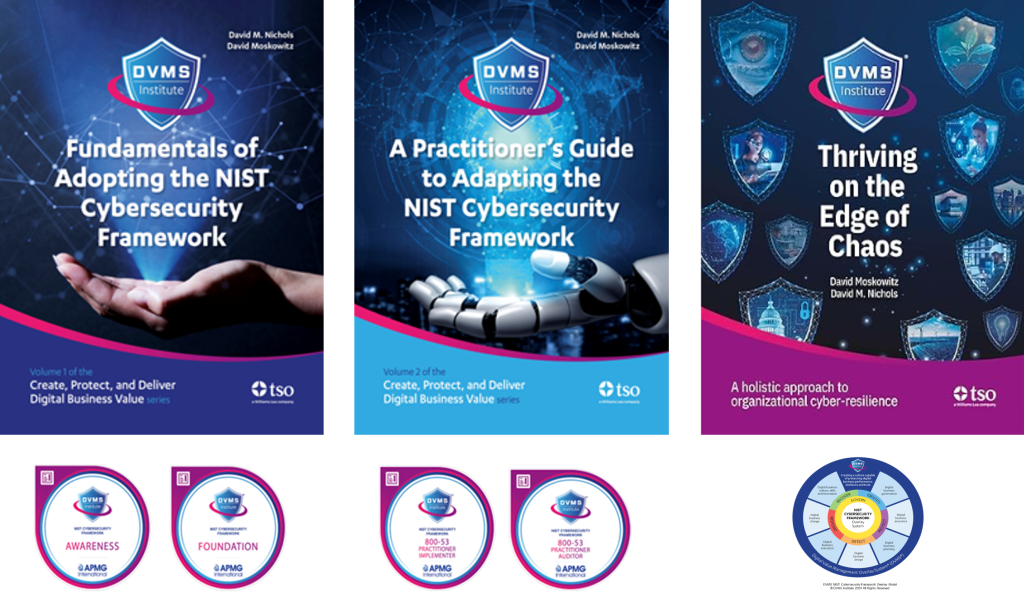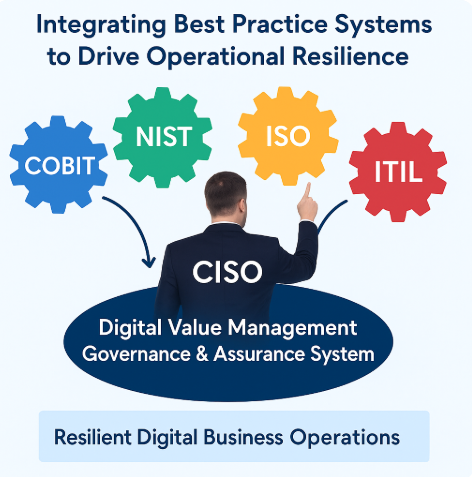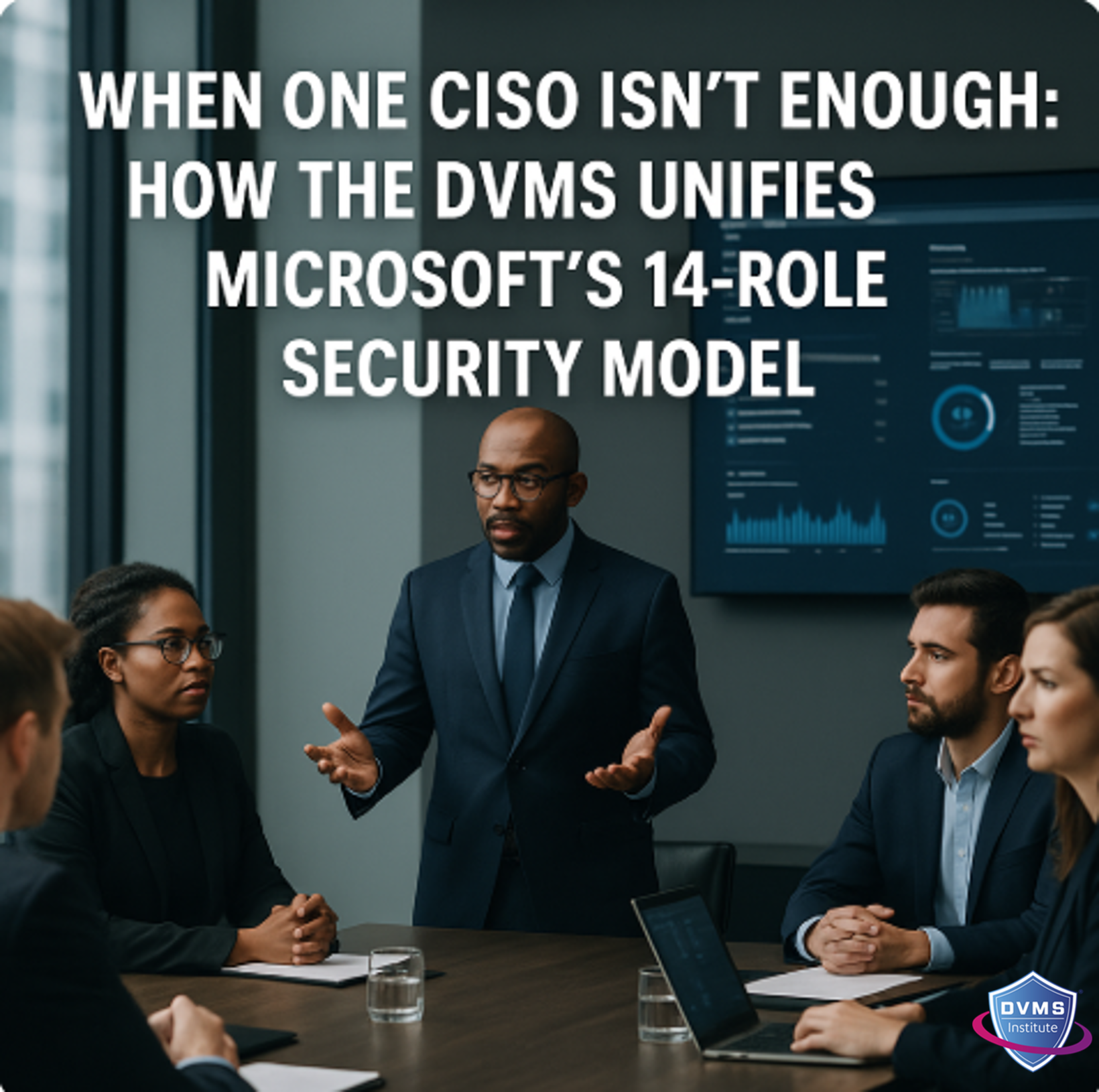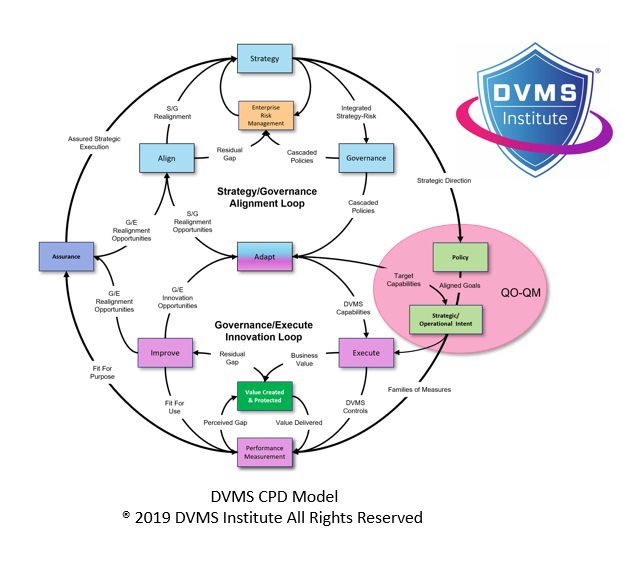A CISO’s Role in Creating an Integrated, Adaptive, and Culture-Driven Governance and Assurance System
Rick Lemieux – Co-Founder and Chief Product Officer of the DVMS Institute
Introduction
In the modern digital economy, organizations are deeply dependent on interconnected digital systems that enable business operations, innovation, and value creation. Yet, this digital dependency also introduces systemic risks—such as cyber threats, compliance challenges, and operational disruptions—that can undermine organizational resilience and trust. As enterprises strive for both agility and assurance, the need for a unified digital value management governance and assurance system has become imperative. Chief Information Security Officers (CISOs), traditionally seen as protectors of information assets, now stand at the strategic crossroads of digital business governance. Their leadership is essential to integrating best practice systems—such as cybersecurity, risk management, IT service management, and compliance frameworks—into a cohesive governance structure that ensures resilient, secure, and high-performing digital operations.
The Expanding Role of the CISO in the Digital Age
The CISO’s role has evolved far beyond managing firewalls and access controls. Today’s CISO is a business leader responsible for ensuring that digital systems enable strategic outcomes safely and reliably. With digital transformation blurring the boundaries between technology and business operations, CISOs must oversee not just cybersecurity but also the assurance of digital trust, resilience, and value delivery.
In many organizations, however, the governance of digital operations remains fragmented. IT, risk management, compliance, and security often operate as separate silos, each following its own framework—ISO 27001 for information security, NIST CSF for cybersecurity, COBIT for governance, ITIL for service management, and so forth. Without integration, these systems generate inefficiencies, gaps, and inconsistencies. The CISO, with visibility across digital risk, technology architecture, and operational dependencies, is uniquely positioned to unify these systems into a cohesive, value-driven framework.
The Need for a Unified Governance and Assurance System
Digital enterprises are complex ecosystems of processes, technologies, and data flows. Each component interacts dynamically, and failure in one area can have a cascading effect across the organization. For example, a misconfigured cloud control, a failed third-party service, or a compliance lapse can quickly escalate into a full-scale operational disruption. Traditional governance models, built for siloed, static systems, cannot effectively manage these interconnected risks.
A unified digital value management governance and assurance system integrates best practice frameworks and operational disciplines into a single management architecture. This system provides a clear line of sight from governance policies to operational execution, linking strategy, risk, performance, and compliance. It aligns digital operations with business objectives, ensuring that security and resilience are not afterthoughts, but embedded into every stage of value creation.
By integrating frameworks such as NIST CSF, ISO 22301 (business continuity), and ITIL (service management) within a digital value management system (DVMS), organizations can transition from compliance-based security to outcome-based governance. This unified model provides decision-makers with actionable intelligence, real-time assurance, and adaptive controls that align digital performance with enterprise goals.
Why CISOs Must Lead the Discussion
The CISO is uniquely qualified to lead the integration of best practice systems because cybersecurity governance intersects with nearly every aspect of digital business. Security is not just about protection—it is about trust, continuity, and assurance. The CISO’s expertise in risk-based thinking, control frameworks, and cross-functional governance enables them to serve as the bridge between executive leadership and operational teams.
Moreover, the CISO’s mandate naturally extends into resilience and assurance. As organizations adopt digital ecosystems spanning cloud platforms, IoT devices, and AI-driven services, ensuring operational integrity becomes inseparable from ensuring cybersecurity. The CISO’s visibility into threats, vulnerabilities, and dependencies makes them the logical leader for developing a unified system of control that safeguards both digital assets and business outcomes.
When CISOs lead the integration of governance systems, they elevate cybersecurity from a reactive cost center to a proactive business enabler. They help establish a common language across departments—translating technical risks into business terms, aligning assurance activities with strategic priorities, and ensuring that digital investments deliver value with resilience and confidence.
The Strategic Value of Integration
Integrating best practice systems under a unified governance architecture provides several strategic advantages:
- Clarity and Alignment: Integration eliminates redundant controls, conflicting priorities, and fragmented accountability. It creates a single framework where governance, risk, and compliance activities align directly with business strategy.
- Operational Efficiency: Unified governance reduces audit fatigue, overlaps, and inefficiencies. Instead of managing multiple compliance programs independently, organizations can harmonize controls and streamline assurance reporting.
- Continuous Assurance: Integrated systems enable real-time monitoring and adaptive response. This shifts assurance from periodic audits to continuous validation of digital trust and operational resilience.
- Improved Decision-Making: When data from IT, security, and operations converge within a single management system, leaders gain visibility into both performance and risk. This data-driven insight empowers informed decision-making at every level of the organization.
- Resilient Value Delivery: Integration strengthens the organization’s ability to anticipate, withstand, and recover from disruptions. It embeds resilience into business design, ensuring that digital services continue delivering value despite adversity.
The CISO’s leadership ensures that these benefits are realized not just technically, but strategically, balancing innovation with assurance, and speed with stability.
The CISO as a Catalyst for Organizational Transformation
Leading the integration of governance systems requires more than technical expertise; it demands cultural and organizational transformation. CISOs must act as change agents who foster collaboration among diverse disciplines, including risk, compliance, operations, and business leadership.
A successful transformation begins with executive sponsorship and a shared vision of digital value management. The CISO must articulate how unified governance supports corporate goals, regulatory expectations, and customer trust. They must also build coalitions across departments, integrating diverse frameworks into a cohesive system without losing their specialized strengths.
Furthermore, the CISO must promote a mindset of digital stewardship, where every employee understands their role in safeguarding value and resilience. Through training, metrics, and governance dashboards, the CISO can embed accountability and transparency across the enterprise.
Governance Through the Lens of Digital Value
Traditional governance focuses on compliance and risk mitigation. Digital value management governance, by contrast, focuses on optimizing the creation, protection, and realization of digital value. It links the organization’s digital assets—data, systems, capabilities, and relationships—to measurable outcomes such as reliability, trust, and customer satisfaction.
Under a unified digital value management system, assurance becomes an enabler of performance. Security controls are no longer seen as constraints but as mechanisms that ensure trust in every transaction, process, and interaction. The CISO’s leadership ensures that governance evolves from being reactive and compliance-driven to being proactive and value-oriented.
By aligning digital assurance with enterprise performance management, CISOs help organizations achieve assured agility—the ability to innovate confidently, knowing that risks are understood, managed, and aligned with business tolerance levels.
Conclusion
The convergence of cybersecurity, digital operations, and business performance has transformed the CISO’s role from a technical defender to a strategic leader of digital trust and value. In an era where digital ecosystems underpin every aspect of enterprise success, fragmented governance is no longer a sustainable approach.
CISOs must lead the discussion on integrating best practice systems into a unified digital value management, governance, and assurance framework. Their leadership ensures that security, risk, compliance, and performance are managed as interconnected dimensions of the same system—one that protects and enables digital value creation.
By driving this integration, CISOs not only strengthen resilience but also elevate the organization’s capacity for sustainable growth, innovation, and stakeholder confidence. In short, the CISO-led integration of best practice systems into a unified governance model is not just a strategic advantage—it is an operational necessity for resilient digital business in the 21st century.
About the Author

Rick Lemieux
Co-Founder and Chief Product Officer of the DVMS Institute
Rick has 40+ years of passion and experience creating solutions to give organizations a competitive edge in their service markets. In 2015, Rick was identified as one of the top five IT Entrepreneurs in the State of Rhode Island by the TECH 10 awards for developing innovative training and mentoring solutions for boards, senior executives, and operational stakeholders.
DVMS Institute®
The DVMS Institute assists organizations in operationalizing the NIST Cybersecurity Framework (CSF) by utilizing a Digital Value Management System® to transform it from a static compliance reference framework into a dynamic system of governance, resilience, and assurance.
Through its Accredited Training Programs, the Institute teaches executives, practitioners, and employees the skills to build an integrated, adaptive, and culture-driven governance and assurance operating system that utilizes NISTCSF Functions, DVMS Models, and other existing best practice systems (GRC, ITSM, etc.) to transform cyber risk into operational resilience.
The DVMS Institute’s courses offer a structured pathway for mastering the integration of governance intent, operational execution, and assurance evidence, enabling organizations to demonstrate measurable resilience, regulatory alignment, and stakeholder confidence in a rapidly evolving digital landscape.
Digital Value Management System® (DVMS)
A Digital Value Management System (DVMS) turns systemic cyber risk into operational resilience by uniting Fragmented Frameworks and Standards—such as NIST, ITSM, GRC, and ISO—into a single, adaptive Governance, Resilience, and Assurance (GRA) operating system that keeps your digital business running, no matter the disruption.
The DVMS doesn’t replace existing frameworks—it connects, contextualizes, and amplifies them, transforming compliance requirements into actionable intelligence that drives and ensures sustained digital operations and performance.
By adopting a DVMS, organizations are positioned to:
- Maintain Operational Stability Amidst Constant Digital Disruption
- Deliver Digital Value and Trust Across A Digital Ecosystem
- Satisfy Critical Regulatory and Certification Requirements
- Leverage Cyber Resilience as a Competitive Advantage
For the CEO, the DVMS provides a clear line of sight between digital operations, business performance, and strategic outcomes—turning governance and resilience into enablers of growth and innovation rather than cost centers.
For the Board of Directors, the DVMS provides ongoing assurance that the organization’s digital assets, operations, and ecosystem are governed, protected, and resilient—supported by evidence-based reporting that directly links operational integrity to enterprise value and stakeholder trust.
For the CIO, the DVMS provides a structured way to align technology investments and operations with measurable business outcomes.
For the CRO, the DVMS provides a way to embed risk and resilience directly into operational processes, turning risk management into a driver of performance and adaptability.
For the CISO, the DVMS provides a continuous assurance mechanism that demonstrates cyber resilience and digital trust across the enterprise and its supply chain.
For Internal and External Auditors, the DVMS provides verifiable proof that the enterprise can maintain operational continuity under stress.

- Architecture Video: David Moskowitz explains the DVMS System
- Case Study Video: Dr. Joseph Baugh Shares His DVMS Story.
- Overlay Model – What is an Overlay Model
- MVC ZX Model – Powers the CPD
- CPD Model – Powers DVMS Operations
- 3D Knowledge Model – Powers the DVMS Culture
- FastTrack Model – Enables A Phased DVMS Adoption
Digital Value Management System® is a registered trademark of the DVMS Institute LLC.
® DVMS Institute 2025 All Rights Reserved




